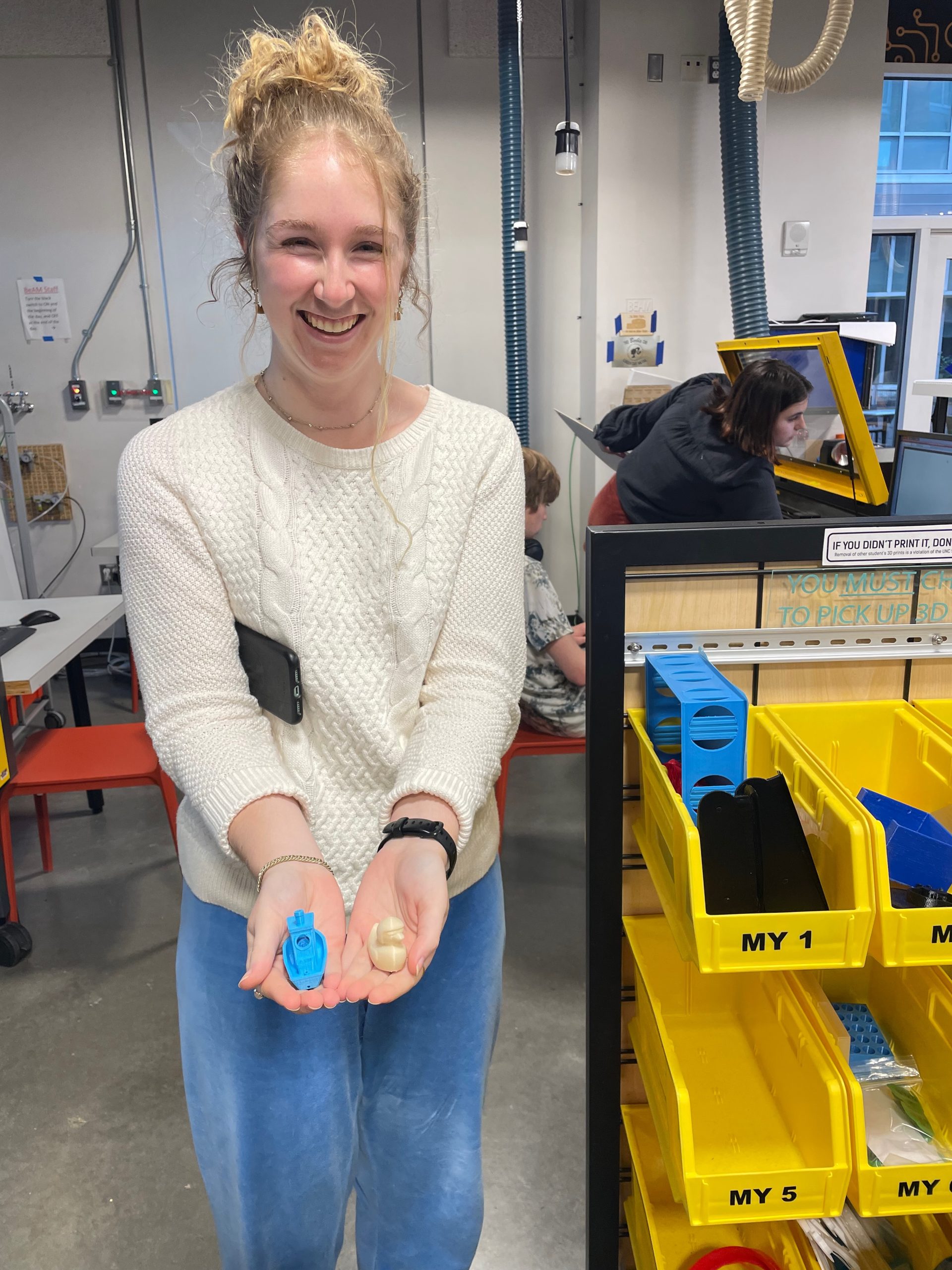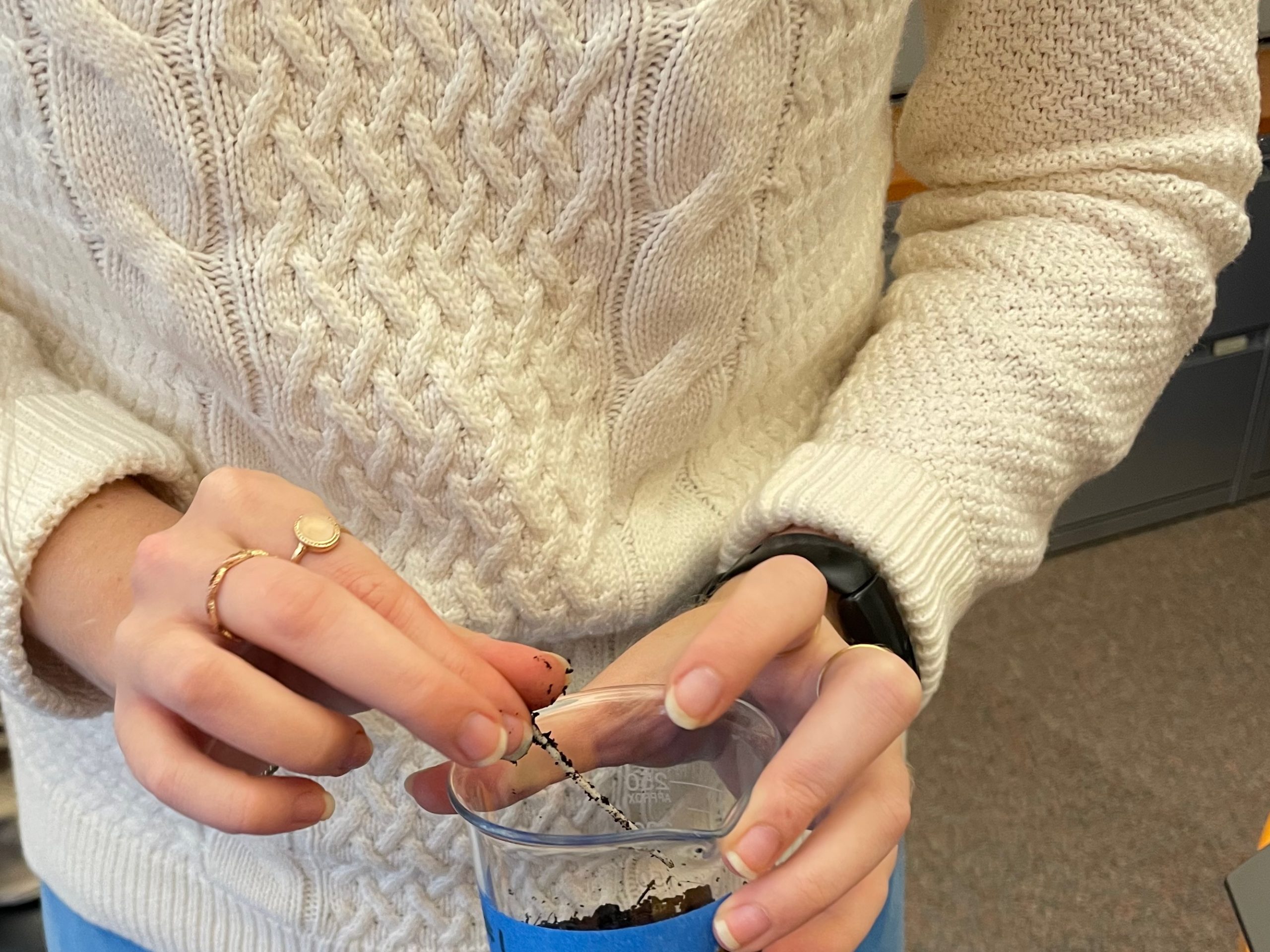
Annabel Grocott moves around her third place – the BeAM makerspace in Murray Hall – with ease. She found the community her sophomore year, during an “Introduction to Design and Making” course. For the final project, Grocott’s group made a light-up ant farm, in the shape of an inverted pyramid.
“I had so much fun during the project that I found myself in the makerspaces all the time,” said Grocott. “I made my family and friends Christmas presents here.”
It was serendipitous that just after finding the space, Grocott opened BeAM’s newsletter to see they were hiring.
“Now I work here, I live here – I’m here all day, every day,” said Grocott.
She loves to lead the BeAM 101 workshop, which introduces students to the many makerspace tools. She feels most at home using the laser cutter. She’s well-versed on the embroidery machine, where she made a friend a Taylor Swift-inspired 22nd birthday sweatshirt. And on the 3D printers, she made her dad a dinosaur-shaped holder for his reading glasses.
But entering her senior year in fall 2023, Grocott’s attention shifted from making to deconstructing.
A string of luck
That is because earlier that year, BeAM made a new 3D printing filament available to its makers. The filament, allPHA, is made from a highly biodegradable plastic called PHA that is coming into wider use.
3D printing projects require a lot trial and error. The hope is that this new material would decrease waste going to the landfill from these projects. The initial supply was made possible through conversations, and a subsequent partnership, between BeAM and Sustainable Carolina Director Mike Piehler.
“BeAM is an amazing asset for the University and takes sustainability into account in their work,” said Piehler. “Sustainable Carolina was in a position to partner with BeAM to quickly advance the sustainability of their popular 3D printing operation.”
It just so happened that Grocott had connections with both Piehler and BeAM. Earlier in her college career, Piehler taught Grocott at the UNC Institute for the Environment’s Sustainable Triangle Field Site. She knew Glenn Walters, BeAM’s senior technical advisor and director of the group’s Design Innovation Hub, through her work at BeAM.
“Glenn told me there might be something I could do with the allPHA for a senior honors thesis project,” said Grocott. “It all fell into place with Mike and Glenn as my advisors. It was really perfect.”
A strategy for waste reduction
With Piehler and Walters, Grocott carved out a well-balanced team for her senior honors thesis. The project would look at how allPHA degrades in a controlled setting. Piehler and Walters were both key in the experimental design process, said Grocott.
For Piehler, the experiment made him think back to his bioremediation research roots.
Piehler’s Ph.D. dissertation focused on impacts and degradation of petroleum pollution in coastal systems. Increasing human activity in coastal areas increases petroleum pollution. Piehler analyzed how these contaminants could be bioremediated, or broken down and removed, in coastal waters.
Although Grocott’s project isn’t looking at petroleum pollution and it doesn’t take place on the coast, it does look at the way a product breaks down under natural conditions.
“Annabel’s project is a great pilot to measure the allPHA’s degradation in the real world,” said Piehler. “Her work looks at a situation that recurs throughout the University (and the world).”
As concern grows around microplastics in our environment, understanding the nature of biodegradable and compostable materials can aid in sustainability efforts.

A sliver of hope
Up Chapman Hall’s grand staircase, inside a cabinet in an office at the end of a suite, Grocott keeps 16 beakers. Each beaker holds nutrient rich compost, generously donated from Edible Campus. All the beakers, except for one control, hold a sliver of the allPHA filament. Some filament pieces are 1.75 mm thick, while others are 3 mm. Before burial, some were used for 3D printing; others were cut off the spool and immediately placed in the dirt.
Walters said the team hoped to create realistic conditions that could indicate how well the material degrades. The rate of breakdown will likely vary based on the filament’s thickness.
“We were not interested in determining if specific organisms were involved with degradation, specific degradation rates or chemical degradation pathways,” said Walters. “Our objectives are pragmatic: Does this material degrade under “normal” soil conditions? How quickly does this material break down? What do the physical degradation products look like?”
The beakers have been sitting covered, in a shallow black crate, since September. Every other week, Grocott intricately measures all 16 slivers. The slivers are removed from the dirt one at a time, rinsed with distilled water, placed on a lab scale and weighed three times. Grocott places each sliver back in the soil before taking out a new one. When she’s done, she waters the compost to make sure it stays damp.
She’ll do this until she presents her findings in April.
With limited time in an academic year, Grocott is testing as many variables as possible. Over the first few months, all the slivers of allPHA showed a slight .01 gram change in mass. Grocott said that between now and the time she presents in April, she hopes to see a bit more change, and is curious if the thinner, 1.75 mm filaments strands will change faster.
“If allPHA can be shown to completely degrade in normal soil and composting operations, without production of residual microplastics, then Carolina could develop a local disposal option for this type of 3D printing waste,” said Walters.
Grocott is also thinking about what this work could mean for makerspaces outside our campus.
“It’s important to see the impacts of degradation,” said Grocott. “What are the benefits to using this filament? Did we invest in something worthwhile? Could what we learn be applied to other Universities and makerspaces?”
An elementary epiphany
As her time at Carolina wraps up, Grocott is looking at graduate schools for environmental engineering. She looks at the problem solving behind engineering to not only create things, but make sure they’re created sustainably.
It’s a far cry from her first days on Carolina’s campus. She recalls feeling overwhelmed by the many different areas of sustainability – materials, recycling, clean technology, communications. She credits her experiences outside the classroom, like those at the Sustainable Triangle Field Site and in the makerspaces, with helping her feel like she can make a difference for the planet.
“In elementary school, we had a lot of workdays in the garden,” recalled Grocott. “We were taught to be kind to the land we live on. That idea permeates my life.”
